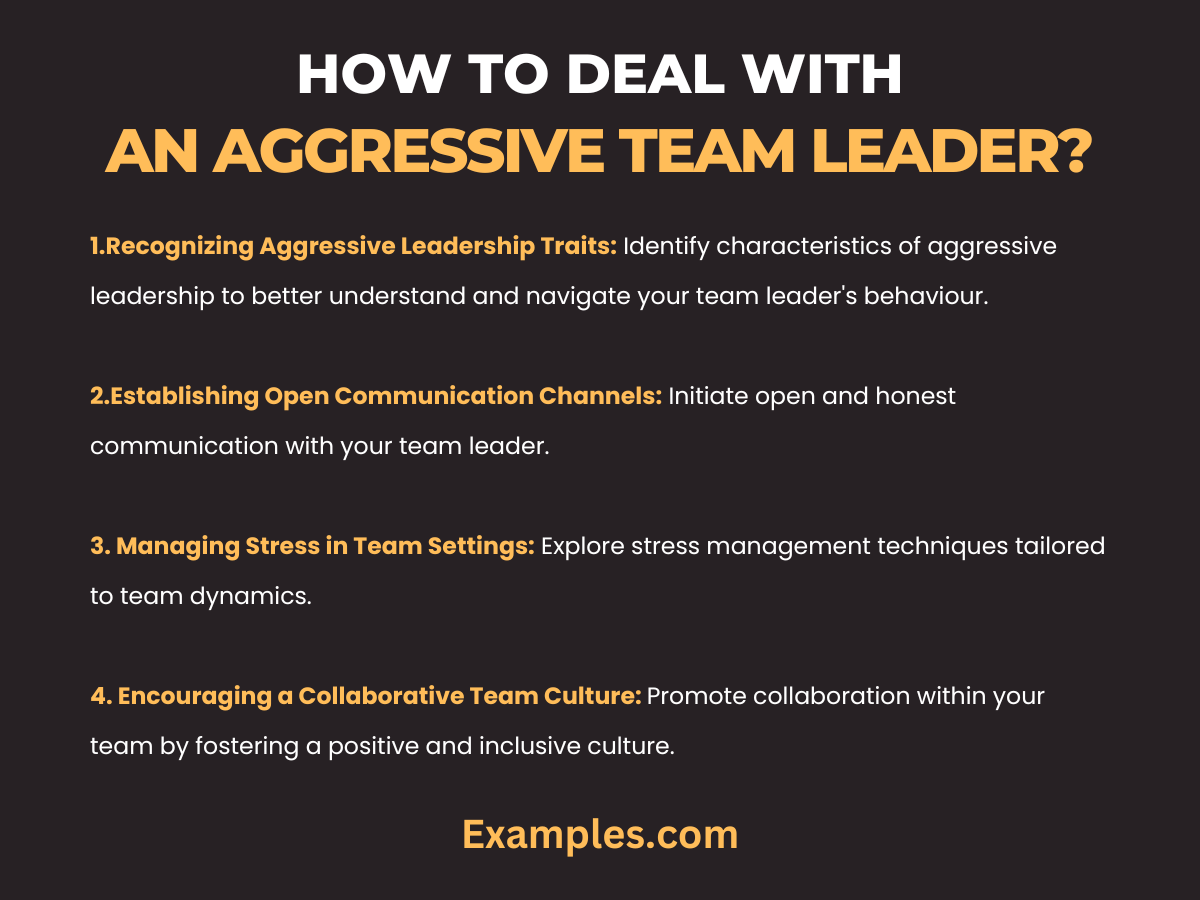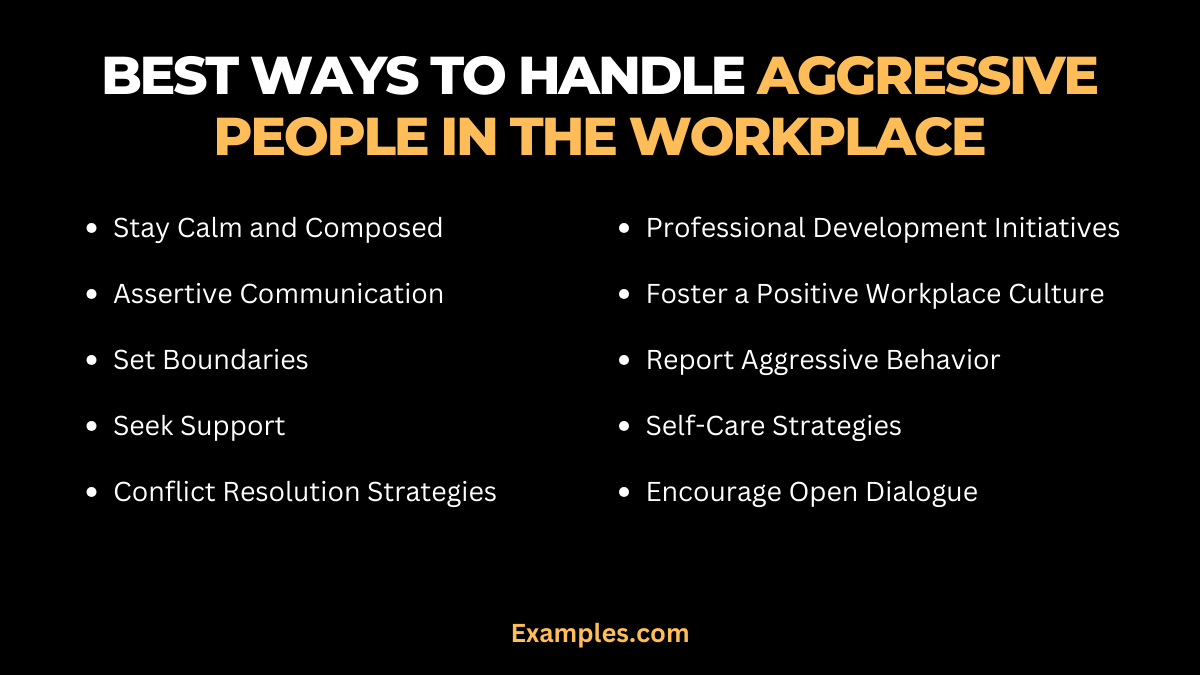How to Deal with Aggressive Team Leader?
Unravel the complexities of dealing with an aggressive boss through our comprehensive guide. Delve into practical strategies, expert tips, and real-world communication examples that empower you to navigate challenging scenarios assertively. Whether addressing aggressive behaviour, managing stress, or fostering a positive work environment, this guide equips you with the tools needed to transform your professional relationship and promote a harmonious workplace.
How to Deal with an Aggressive Team Leader?
Navigating a work environment with an aggressive team leader requires strategic finesse. In this comprehensive guide, explore effective techniques for addressing and managing an assertive team leader. From open communication strategies to stress management, empower yourself to create a healthier team dynamic.

- Recognizing Aggressive Leadership Traits
Identify characteristics of aggressive leadership to better understand and navigate your team leader’s behaviour. Recognizing these traits is the first step in developing effective coping mechanisms. - Establishing Open Communication Channels
Initiate open and honest communication with your team leader. Learn how to express concerns, provide constructive feedback, and foster an environment where communication is valued. - Managing Stress in Team Settings
Explore stress management techniques tailored to team dynamics. From mindfulness practices to collaborative problem-solving, discover effective ways to alleviate stress in a team led by an assertive leader. - Encouraging a Collaborative Team Culture
Promote collaboration within your team by fostering a positive and inclusive culture. Learn strategies to encourage teamwork, manage conflicts constructively, and enhance overall team dynamics. - Seeking Support within the Team
Build a support network within your team. Encourage open discussions about the team leader’s behaviour, share experiences, and collectively develop strategies to address and manage aggression. - Evaluating Long-Term Solutions
Assess the long-term compatibility of your career goals within the current team structure. Explore potential changes or shifts that align better with your professional and personal well-being.
How Do You Deal with Aggressive Leadership?
Effectively managing aggressive leadership involves a multifaceted approach. This guide explores actionable strategies for addressing and mitigating the impact of aggressive leadership styles within the workplace.
- Assessing the Impact of Aggressive Leadership
Understand the impact of aggressive leadership on team dynamics, productivity, and overall work atmosphere. Assessing these effects is essential for developing targeted coping mechanisms. - Communicating Assertively with Leadership
Learn how to communicate assertively with an aggressive leader. Discover effective ways to express concerns, set boundaries, and foster open communication channels that benefit both you and the team. - Building Resilience in Leadership
Develop resilience in the face of aggressive leadership. Explore techniques to maintain composure, manage stress, and cultivate a mindset that enables you to navigate challenges with grace. - Collaborative Conflict Resolution
Explore collaborative approaches to conflict resolution. Learn how to address conflicts directly, find common ground, and work towards solutions that benefit the team and maintain a positive work environment. - Seeking External Support
If aggressive leadership persists, consider seeking support from higher management or HR. Document instances of concern and collaborate with the appropriate channels to explore resolution options. - Encouraging Leadership Development
Promote leadership development within your organization. Encourage training and support for leaders to develop more effective and positive leadership styles, benefitting the entire team. - Nurturing a Positive Workplace Culture
Participate in cultivating a positive workplace culture. Contribute to initiatives that promote teamwork, respect, and open communication, creating an environment that encourages leadership growth and collaboration.
What are the Characteristics of an Aggressive Team Leader?
Understanding the traits of an aggressive team leader is crucial for navigating workplace dynamics. In this comprehensive guide, we explore distinct characteristics that define aggressive leadership and provide insights on how to identify and address them effectively.
- Dominance and Authoritarianism
Aggressive team leaders often exhibit a dominating and authoritarian demeanour. Learn to recognize signs of excessive control and explore strategies for fostering a more collaborative and inclusive team culture. - Lack of Empathy
Explore the impact of a leader’s lack of empathy on team dynamics. Discover ways to address this characteristic constructively, fostering a more compassionate and supportive work environment. - Poor Communication Skills
Communication breakdowns can contribute to aggression. Learn to identify deficiencies in a leader’s communication style and explore methods to enhance team communication, promoting clarity and understanding. - Micromanagement Tendencies
Aggressive leaders may lean towards micromanagement, stifling team autonomy. Explore techniques to address micromanagement and empower teams to thrive under more trust-based leadership. - Inconsistent Feedback
Examine the role of inconsistent feedback in aggressive leadership. Discover strategies for promoting transparent and constructive feedback loops that contribute to individual and team growth.
What are the Best Ways to Handle Aggressive People in the Workplace?
Dealing with aggressive individuals in the workplace requires a strategic and empathetic approach. Explore effective ways to handle aggression, diffuse tense situations, and foster a positive and collaborative work environment.

- Stay Calm and Composed
Maintaining your composure is key when confronted with aggression. Learn techniques to stay calm, assess situations objectively, and respond thoughtfully to diffuse tension. - Assertive Communication
Developing assertive communication skills is crucial for handling aggression. Explore techniques to express your thoughts and feelings assertively, fostering open and respectful dialogue. - Set Boundaries
Establish clear boundaries to protect your well-being. Learn to communicate and reinforce your limits effectively, creating a more balanced and respectful workplace. - Seek Support
Don’t hesitate to seek support from colleagues, HR, or mentors when dealing with aggression. Collaborate with others to gain insights, share experiences, and navigate challenges collectively. - Conflict Resolution Strategies
Explore conflict resolution strategies tailored to handle aggression. From active listening to compromise, discover approaches that contribute to positive resolution and a healthier workplace culture. - Professional Development Initiatives
Promote professional development initiatives that address aggression. Invest in training programs and resources that enhance interpersonal skills, emotional intelligence, and leadership capabilities. - Foster a Positive Workplace Culture
Contributing to a positive workplace culture can mitigate aggression. Learn strategies for promoting inclusivity, appreciation, and collaboration to create an environment that discourages aggressive behaviour. - Report Aggressive Behaviour
In cases of persistent aggression, be prepared to report inappropriate behaviour to the appropriate channels. Understand the reporting process and collaborate with HR to address concerns and seek resolution. - Self-Care Strategies
Prioritize self-care strategies to manage the impact of dealing with aggression. Explore techniques to maintain your mental and emotional well-being, ensuring you navigate workplace challenges resiliently. - Encourage Open Dialogue
Create opportunities for open dialogue about workplace aggression. Encourage team discussions, address concerns collaboratively, and work towards establishing a culture of mutual respect and understanding.
In conclusion, navigating an aggressive team leader requires strategic approaches outlined in this comprehensive guide. By recognizing and addressing aggressive leadership traits, implementing effective handling strategies, and fostering a positive workplace culture, individuals can transform challenging dynamics. This guide, rich with examples and insights, empowers teams to navigate aggression assertively, fostering a healthier and more collaborative work environment.



